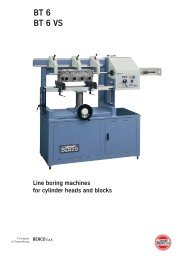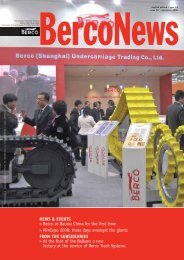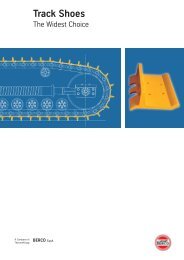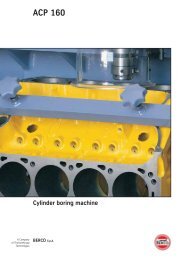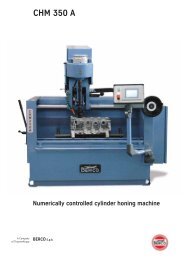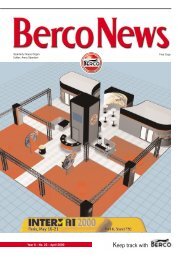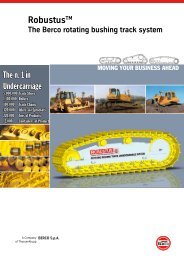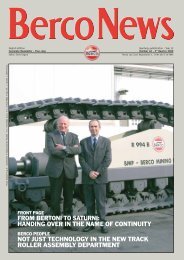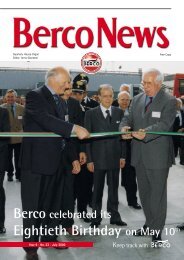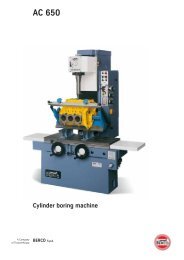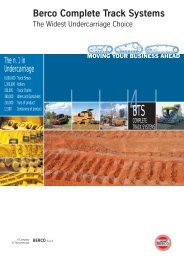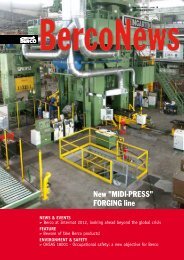Nuova linea di stampaggio ''MIDI-PRESS'' - Berco S.p.A
Nuova linea di stampaggio ''MIDI-PRESS'' - Berco S.p.A
Nuova linea di stampaggio ''MIDI-PRESS'' - Berco S.p.A
- No tags were found...
You also want an ePaper? Increase the reach of your titles
YUMPU automatically turns print PDFs into web optimized ePapers that Google loves.
PECIALNews & Eventsthe first to be marketed by <strong>Berco</strong>with a thrust of over 200 tons.As always, the visitors to the standwere many; hundreds of customers,dealers and personnel from ourcompetitors flocked toour stand inthe 3 daysof the fair,confirming theaffection andregard reservedfor the <strong>Berco</strong>brand in thiscountry. Therewere also lotsof namesadded to thedatabase byour sales staffon the stand,with a view tostrengtheningB e r c o ' spresence in the mining industry.We would like to thank everyonewho chose to visit the <strong>Berco</strong> stand,especially our long-term customersand dealers, but also all the newvisitors with whom we hope toBAUMA CHINA 2012,<strong>Berco</strong>'s third time as exhibitorMore visitors, more exhibitors, moreexhibition space: in spite of the marketslowdown the sixth e<strong>di</strong>tion of BaumaChina held in late November at theShanghai New International Expo Centrehas exceeded all previous recordsestablish equally fruitful businessrelationships in the near future.And we mustn't forget to thank allthe personnel from <strong>Berco</strong> SpA and<strong>Berco</strong> of America who contribute<strong>di</strong>n a decisive way to the success ofthis event.Goodbye for now– see you all atthe next Minexpoin 2016!Guido BottinDirector ofOperations,<strong>Berco</strong> of AmericaSince it was first staged in 2004, BaumaChina has been one of the lea<strong>di</strong>ng tradefairs for the entire construction and buil<strong>di</strong>ngmaterial machinery industry throughout Asia.The 2012 event established a new record,with an impressive set of numbers.All the international key players exhibitedtheir machines and products at BaumaShanghai, and of course <strong>Berco</strong> was one ofthem.BN64 > december 2012 7
Green light to theidler assembly at <strong>Berco</strong> UKMay 2012 heralded the longawaited commencement oflocalised idler assembly at <strong>Berco</strong>UK.Following a visit to the Castelfrancoplant by two employees in April,they came back armed with photos,videos and ideas.The operation required a significantinvestment, totalling approximately€200k €euro which was mainly madeup of two press machines and awash machine. In order to ensurethat the process runs as smoothlyas possible it has been essentialto have close collaboration withour colleagues in Copparo. This hasallowed our team to solve anyproblems that have arisen quicklyand in the most appropriate way.This has also benefitted thecompany in that we have gainedfirst time quality approval from ourmain OEM customers.We are currently buil<strong>di</strong>ng themajority of JCB supplied idlers withthe bulk of KUK idlers to beassembled in 2013, with the idlersbeing fitted to excavators from 14to 40 tons.Capacity at present is approximately18 idlers assembled per day withthis figure doubling over the nextyear. The introduction of thislocalised assembly has allowed usto significantly improve the leadtime, especially for our aftermarketcustomers which will decrease toAutomated BUSHINGGRINDING and POLISHING cellsapproximately20 days. Thecompany hasrecently takendelivery of a brand new washmachine that will allow thecomponent parts to run on aconveyor thus enabling the processto become much more efficient.The full assembly process isplanned for completion in January2013. The current operationemploys two people with theintention to double that figure bythe end of 2013.Paul Taylor<strong>Berco</strong> UK General ManagerTwo grin<strong>di</strong>ng and polishing cells for lubricated track chain bushings have recently come intooperation. The new equipment operates automatically, bringing many advantagesAbout six months ago, in the pins and bushingsgrin<strong>di</strong>ng department, two automated lubricatedtrack chain bushing grin<strong>di</strong>ng and polishing cellscame into operation.Technologically, this has meant the replacement ofthe manual lapping process, which was carried outan a machine physically separate from the grinderand with no automated workpiece unloa<strong>di</strong>ng system.The newly installed equipment works automatically,bringing a number of advantages:• Reduction of manual handling in loa<strong>di</strong>ng operations– the lapping machineloa<strong>di</strong>ng and unloa<strong>di</strong>ngoperations have beeneliminated, using a loa<strong>di</strong>ngbelt connected to thegrinder and a robot thatunloads the workpieces inan orderly way into theirfinal container;• Reduction of costs, byupgra<strong>di</strong>ng to a fastermachine and increasingproduction considerably;• Improved environmental con<strong>di</strong>tions thanks to thereduced presence of abrasives in the departmentand a consequent reduction in waste <strong>di</strong>sposal costsof and improved general cleanliness;• Reduction in costs and complications related tothe cleaning of the finished products, which, thanksto the new polishing process, no longer requirewashing;• Shorter set-up times (just a few minutes for thepolishing) in the context of a lean production setupand a gradual reduction of numbers in the batches.Carlo Zar<strong>di</strong>Track Chains and Shoes AreaManagerMarco MuneratoProcess Improvement StaffBN64 > december 20129
Innovation & TechnologyNew LOADING SYSTEMS with ARTIFICIAL VISIONIndustrial automation, based on the use of anthropomorphic robots, wasfirst introduced at the beginning of the 1980s, with the aim of freeingoperators from more physical, lower value-added tasksNow, in the world of automation, a newfrontier is emerging, that of anthropomorphicrobots controlled not simply by handlingsoftware but by intelligent programs thatinterpret images captured by cameras – inother words, artificial vision systems.This new technology has been made possible– and applicable at an industrial level – bythe ever more dynamic miniaturisation ofphoto-video viewing systems and theirexpansion into the consumer market, with aconsequent reduction in costs.Thus, after years of experiments and laboratorytesting, this technology is now beginning tobe applied on an industrial scale.As a consequence of this, two roller wel<strong>di</strong>ngcells with artificial vision loa<strong>di</strong>ng systemshave been installed in <strong>Berco</strong>'s Copparo factory.The roller halves are thus taken from thecontainer by an anthropomorphic robot, whichreceives instructions from a three-<strong>di</strong>mensionalvision system developed by SIR of Modena.The vision system, operated by secondanthropomorphic robot by means of a laserscanner,scans the container, processes theimage, compares the result to the mathematicalmodel of the half-roller currently in productionand identifies the most easily removable halfrollers.The handling robot sets its target in this wayand then moves the half-roller from the container toan interme<strong>di</strong>ate point, where it is analysed again by asecond vision system – this time two-<strong>di</strong>mensional – torecognise the position of its edge (edge detection).The loa<strong>di</strong>ng robot now has all the information it needsto handle the item correctly, and can proceed withloa<strong>di</strong>ng the wel<strong>di</strong>ng machine.The same robot can also supply the finishing machinedownstream of the wel<strong>di</strong>ng cell.The new thing about this application is that the systemis able to analyse items stacked randomly in a container,and not just those arranged on a horizontal surface, asin the more common applications. This makes the setupprocedure more complex, and SIR and <strong>Berco</strong> areworking continuously to make improvement in this area.The set-up/optimisation activity regards both thecalculation algorithms for the main software and themechanical handling equipment, which has to handleall the items passing through the cell with a singlegripper, in order to avoid continuous tooling operations.The installation of these handling/wel<strong>di</strong>ng cells upstreamof finishing machines makes it possible to keep bothproduction lead times and interoperational buffers low.Once optimised, fully robotic handling can considerablyreduce the problems related to the manual handling ofloads. The possible prospects of this approach are clearto see and can lead to improvements in all thecomponent handlingoperations which, generally,are currently performed bythe machine operator.It can also lead to a higherlevel of training for theoperators, who, oncerelieved of these tasks, canbecome more involved inprocess/system controlactivities.Nicola AntoliniHead of Rollers Area10BN64 > december 2012
From the subsi<strong>di</strong>ariesTRACK LINK PROCESSING at BERCOSHANGHAI: winning greater salesvolumes in ChinaThe main market for me<strong>di</strong>um size excavators(from 14 to 40 tons) is now the Chinese one.In 2011 a production peak of about 180,000machines was reached, a substantial percentageof the world production figure. In order to wina greater volume of thissection of the market,<strong>Berco</strong> is investing inthe localisation ofcomponents.The main competitiveadvantages oflocalisation are theelimination of customsduties, reduced leadtime and greatercost stability, in amacroeconomic scenariocharacterised by sharplyfluctuating currencyexchange rates.Two years have gone by since the productionof pins and bushings for excavator track chainsbegan in the then newly opened Shanghaifactory. Now that the production hasconsolidated, the time has finally come for thelocalisation of track link processing.<strong>Berco</strong> approaches these localisation processesin such a way as to guarantee the outstan<strong>di</strong>ngquality of its products and compliancewith specifications, regardless of wherethe manufacturing takes place. One woul<strong>di</strong>magine that for a company like <strong>Berco</strong>, thatproduces 8 millions track links every year, thelocalisation of track link processing would bestraightforward, but this is not the case. Infact, this is the first time that these componentsare being produced out of our Italian factories.At this stage, the localisation doesn't involvejust the processing but also the procurement of theforged parts from local suppliers, until such a time asmarket volumes allow us to set up our own forging.Thus, a number of actions have been taken in advanceto certify the suppliers of both the raw materials andthe forging, actionswhich have involvednot only the forgingand processing ofChinese steel in Italy,but also the processingof links forged in Chinaon lines in Copparo.These trials andsubsequent tests havehad positive results,thus allowing us toproceed with thelocalisation of themachining and heattreatment processes inthe Shanghai factory. To prepare itself in the bestpossible way for this challenge, <strong>Berco</strong> Shanghai hasorganised specific training courses for some of itsengineers at the Copparo factory, to familiarise themwith the problems related to the machining and heattreatment of the links.Just as in the Italian factories, the track links will beproduced on de<strong>di</strong>cated machines that carry outmillingof the shoe mounting and link-rail faces the quenchingand tempering and, finally, the boring and drilling. Afurther machine performs the nut seat machining ontrack links requiring this process.This work is due to start at the beginning of the NewYear, after the setting up of the lines with the help ofItalian engineers.The pitch range covered goes from 190 mm to 228.6mm, allowing the processing of track links for excavatorsranging from18 to 50 tons.In this initial stage the production capacity will be 400tracks, which will double in a second planned stage.Andrea MinguzziOperations ManagerBN64 > december 2012 11



